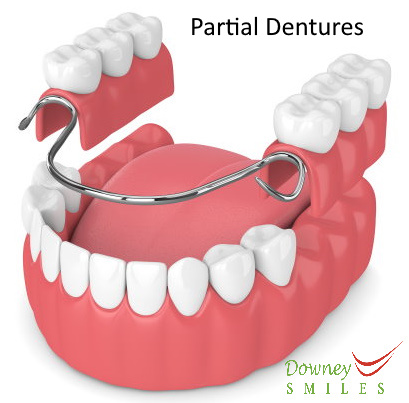 Partial dentures are removable dentures that replace two or more teeth in the upper or lower area of your mouth, restoring both the functional (chewing and biting) and cosmetic concerns associated with missing teeth. There are two types of partial dentures: removable and fixed. A removable partial denture can be worn and removed as needed. A fixed partial denture is constantly present in the mouth and does not need to be removed. Our partial dentures dentist, Dr. Amit Shah has over 20+ years of experience with dentures since 2002 and gives experienced advise on what type of partial dentures will work best for you.
Partial dentures are removable dentures that replace two or more teeth in the upper or lower area of your mouth, restoring both the functional (chewing and biting) and cosmetic concerns associated with missing teeth. There are two types of partial dentures: removable and fixed. A removable partial denture can be worn and removed as needed. A fixed partial denture is constantly present in the mouth and does not need to be removed. Our partial dentures dentist, Dr. Amit Shah has over 20+ years of experience with dentures since 2002 and gives experienced advise on what type of partial dentures will work best for you.
Table of Contents
What are Partial Dentures?
A partial denture is a removable dental appliance that consists of one or more fake teeth that rest on a plastic or metal base that is the same color as the roof of your mouth. A partial denture replaces one or more missing teeth to overcome the practical and cosmetic issues associated with missing teeth. Partial dentures are also used for individuals who cannot have a bridge because they lack the necessary teeth to support the bridge or who cannot afford a bridge treatment.
What are the types of Partial Dentures?
Partial dentures are classified into two types: removable partial dentures and fixed partial dentures. A removable partial denture can be worn and removed as needed. A fixed partial denture is fixed in your mouth and cannot be removed.
What are Removable Partial Dentures?
Replacement teeth are connected to a gum-colored acrylic foundation in a removable partial denture. It is not permanently attached to your mouth cavity and may be readily removed.
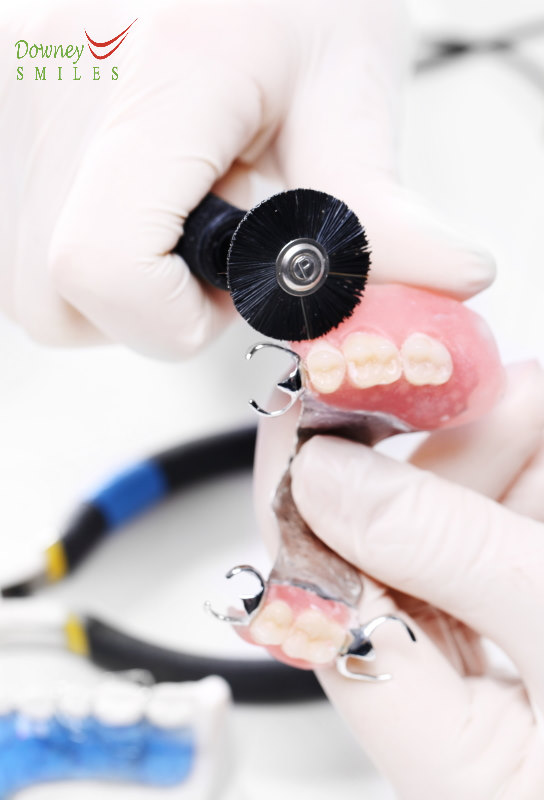
Cast Metal Framework Partial Dentures. A removable partial denture features a cast metal framework, high-quality replacement teeth, and precise attachments.

Acrylic Clasp Partial Dentures. The most affordable partial denture is acrylic clasp partial dentures with replaceable acrylic flippers. It employs acrylic clasps, which are less effective than cast metal clasps and should only be used as a temporary remedy due to their lack of aesthetics and uncomfortable to wear.
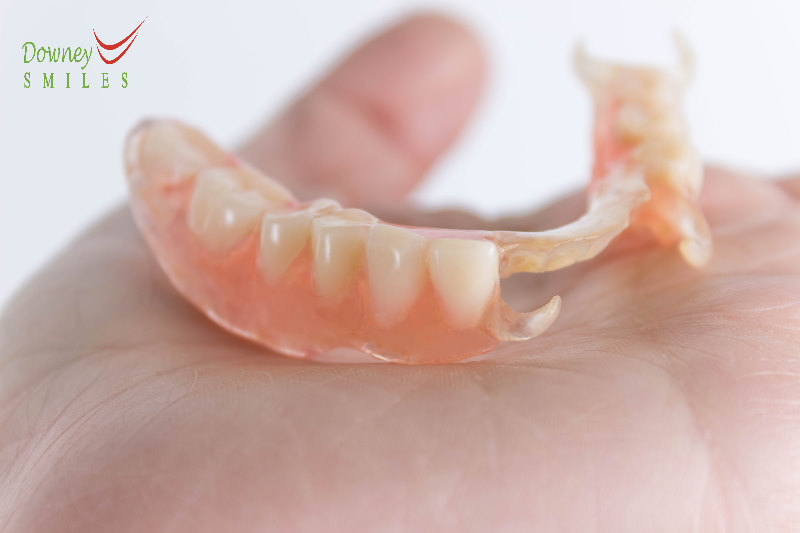
Flexible Partial Denture. Fixed partial denture clasps are gum-colored, making them less apparent than acrylic clasps. These are alternatives for folks who are allergic to acrylic. It is more pleasant than acrylic, but the comfort and beauty come at a price since flexible partial dentures are more costly.
What are Fixed Partial Dentures?
Fixed partial dentures are made up of a row of prosthetic teeth that are screwed or mechanically attached or kept to the natural teeth and are held in place by teeth implants. Natural teeth or roots close to the gap to replace lost teeth provide support for the fixed partial denture.
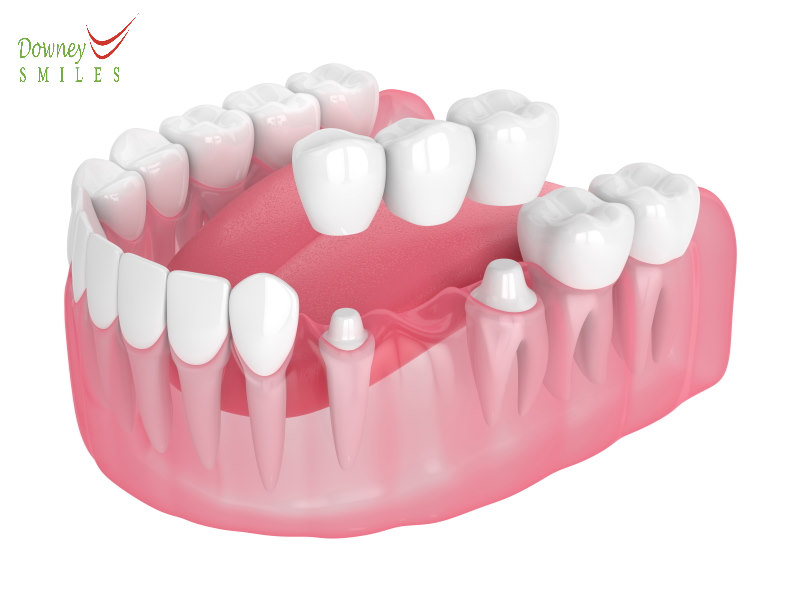
Fixed Bridge. A fixed bridge is permanently linked to the surrounding teeth or dental implants. The patient must have healthy surrounding teeth while they are filed down and prepared to support the crowns.
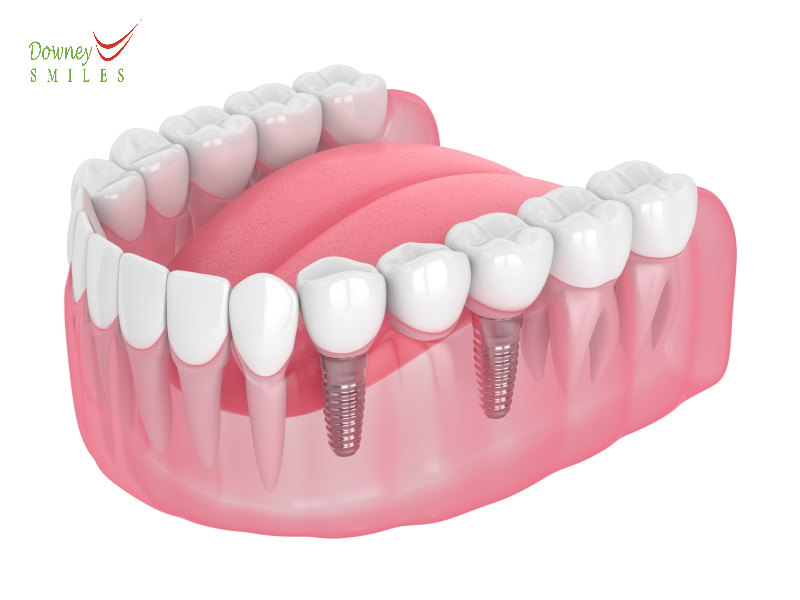
Implant-supported Fixed Bridge. Small posts of biocompatible titanium are permanently implanted in your mouth to support a fixed bridge. This type of partial denture is indicated for individuals who are missing neighboring teeth or wish not to compromise their remaining teeth.
How does the Partial Dentures Process Work?
Because partial dentures are custom-made for you, a process is followed to guarantee that they fit, look, and work perfectly. The following steps are commonly involved in the partial denture process.
- A dental checkup. A dental checkup is the first step in establishing the state of your teeth and oral health. During the inspection, we will search for any symptoms of illness, tooth decay, or past dental treatment that might interfere with the denture procedure. We will also search for teeth that may need to be extracted before installing the dentures.
- Creating your dentures. Once we determine that you are a good candidate for partial dentures and your gums have healed completely, we will take a mold of your teeth and measurements to guarantee that your dentures fit perfectly. These measurements are forwarded to the lab, which will fabricate the dentures according to the parameters.
- Fitting the dentures. You will be summoned to our office for a fitting when the dentures are finished. You should not feel discomfort or have any other problems when you wear it. We next make any required changes to your dentures.
You will need some time to adjust to wearing your prosthesis. You may have some trouble eating and speaking with it at first, but if you’re properly used to your dentures, it will have the same function and control over your teeth.
Make an appointment with Dr. Kurt Tran DDS at Best Smiles Dental!
* FREE Dental Implant Smile Consultation ($100 Value)
* FREE Digital X-rays especially for Tooth Implant ($150 Value)
* We Maximize your Insurance so you pay less out of pocket.
* 0% Interest Financing for 18 months
How long does it take to get Partial Dentures?
Before partial dentures are put in, it takes six to eight weeks following tooth extraction. Each patient is unique. Some people wait many months, while others wait a few weeks before receiving their dentures.
What are common problems with Partial Dentures?
Partial dentures, like any other dental prosthesis, can cause complications. Some of the most prevalent issues with partial dentures are listed below.
- During the early phases of the adjustment period, soreness and discomfort are expected. The pain and irritation are frequently caused by new dentures pressing against your mouth.
- As people grow acclimated to their new dentures, they will feel funny in their mouths, making it difficult to talk normally.
- Most patients have difficulty eating normally because their mouths are still adjusting to the dentures or because their gums are healing.
- Food particles quickly lodge in your partials, prone to bacteria accumulation if not cleansed immediately.
- Slipping dentures are expected, especially if your mouth is still adjusting to them. During this period, the dentures are readily dislodged when eating or talking.
Am I a Good Candidate for Partial Dentures?
Partial dentures are used by people who have lost one or more teeth but not all of their teeth. In other circumstances, however, dentures may not be the ideal solution for patients. A list of candidates for complete dentures is provided below.
- You have healthy gum tissue and jawbone.
- You are not a good candidate for dental implants.
- Your teeth have been damaged, broken, or decayed way beyond repair.
- You have difficulty chewing food.
- You have low self-confidence because of your missing teeth.
How long do Partial Dentures Last?
According to the American Dental Association, partial dentures have a 15-year lifespan. During this period, your mouth and dentures may vary significantly, affecting the fit and look. Have your dental expert evaluate if you’ve been wearing your dentures for longer than their projected lifespan.
What do Partial Dentures look like?
Plates with one or more false teeth are used in partial dentures. It’s kept together by a plastic or metal foundation that matches the color of your mouth’s roof. It may be secured to your teeth with clasps or precise attachments. It resembles a retainer; only you don’t have to remove your partial dentures to eat.
How much do Partial Dentures Cost?
The cost of partial dentures ranges from $1,400 to $1,800, depending on the number of teeth and location. The cost is also determined by whether some of your teeth must be extracted or whether any other procedures are required before the partial dentures are fitted.
How to care for Partial Dentures?
The procedures outlined below will assist you in ensuring your partial dentures last for years.
- Before cleaning, fill the sink with water or lay down a soft towel to prevent it from breaking if you drop it.
- After each meal, rinse your partial denture with warm water to eliminate plaque and food residue. Using boiling or boiling water causes the partial to distort and affects its fit.
- Brush your partial dentures using a soft toothbrush or brush and denture paste daily—regular toothpaste is too abrasive and produces scratches in the acrylic.
- After soaking, gently rinse your partial under warm water before reinserting it into your mouth.
- Clean your partials regularly to avoid germs growth.
What are the disadvantages of Partial Dentures?
The following are some of the most common drawbacks of partial dentures.
- It takes some time to be acclimated to partial dentures.
- It does not perform as well as dental implants or bridges.
- It increases the chance of plaque collection around the abutment teeth and gum line, leading to gum disease and tooth damage.
- It puts pressure on your ridges and the underlying jawbone, causing resorption over time.
FAQs for Partial Dentures
What are the best partial dentures to get?
There are many types of partial dentures that can be used to replace missing teeth. Most patients feel that flexible partial dentures are superior to more rigid acrylic dentures because they are lighter, more flexible, and thinner.
Do partials damage teeth?
If not properly cared for, a removable partial denture can raise plaque on the neighboring teeth, leading to cavities and gum disease. Because of frequent pressure or movement, they also cause stress to the abutment teeth. However, appropriate cleanliness and partial denture maintenance prevent this from happening.
Areas we Serve
Our office serves the following communities.
